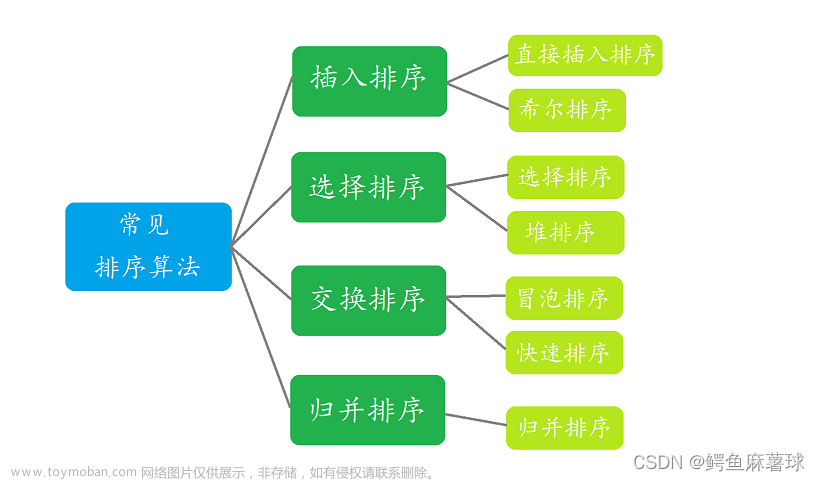目录
1 -> 选择排序
1.1 -> 基本思想
1.2 -> 直接选择排序
1.2.1 -> 代码实现
1.3 -> 堆排序
1.3.1 -> 代码实现

1 -> 选择排序
1.1 -> 基本思想
每一次从待排序的数据元素中选出最小(或最大)的一个元素,存放在序列的起始位置,直到全部待排序的数据元素排完。
1.2 -> 直接选择排序
- 在元素集合arr[i] -- arr[n - 1]中选择关键码最大(或最小)的数据元素
- 若它不是这组元素中的最后一个(或第一个)元素,则将它与这组元素中的最后一个(或第一个)元素交换
- 在剩余的arr[i] -- arr[n - 2] (arr[i + 1] -- arr[n - 1]) 集合中,重复上述步骤,直到集合剩余1个元素

直接选择排序的特性总结:
- 好理解,但效率不是很好,实际中很少使用
- 时间复杂度:
- 空间复杂度:
- 稳定性:不稳定
1.2.1 -> 代码实现
#define _CRT_SECURE_NO_WARNINGS 1
#include<stdio.h>
#include<stdlib.h>
#include<stdbool.h>
// 交换
void Swap(int* x, int* y)
{
int tmp = *x;
*x = *y;
*y = tmp;
}
// 打印
void PrintArray(int* a, int n)
{
for (int i = 0; i < n; i++)
printf("%d ", a[i]);
printf("\n");
}
// 选择排序
void SelectSort(int* a, int n)
{
int begin = 0, end = n - 1;
while (begin < end)
{
int maxi = begin, mini = begin;
for (int i = begin; i <= end; i++)
{
if (a[i] > a[maxi])
{
maxi = i;
}
if (a[i] < a[mini])
{
mini = i;
}
}
Swap(&a[begin], &a[mini]);
// 如果maxi和begin重叠,修正一下即可
if (begin == maxi)
{
maxi = mini;
}
Swap(&a[end], &a[maxi]);
++begin;
--end;
}
}
void TestSelectSort()
{
int a[] = { 9, 2, 6, 1, 7, 3 ,0, 5, 8, 4 };
PrintArray(a, sizeof(a) / sizeof(int));
SelectSort(a, sizeof(a) / sizeof(int));
PrintArray(a, sizeof(a) / sizeof(int));
}
int main()
{
TestSelectSort();
return 0;
}
1.3 -> 堆排序

堆排序特性总结:
- 堆排序用堆来选数,效率较高
- 时间复杂度:
- 空间复杂度:
- 稳定性:不稳定
1.3.1 -> 代码实现
#define _CRT_SECURE_NO_WARNINGS 1
#include<stdio.h>
#include<stdlib.h>
#include<stdbool.h>
// 交换
void Swap(int* x, int* y)
{
int tmp = *x;
*x = *y;
*y = tmp;
}
// 打印
void PrintArray(int* a, int n)
{
for (int i = 0; i < n; i++)
printf("%d ", a[i]);
printf("\n");
}
// 堆排序
void AdjustUp(int* a, int child)
{
int father = (child - 1) / 2;
while (child > 0)
{
if (a[child] > a[father])
{
Swap(&a[child], &a[father]);
//更新下标
child = father;
father = (father - 1) / 2;
}
else
{
break;//一旦符合小堆了,就直接退出
}
}
}
void AdjustDown(int* a, int n, int parent)
{
int child = parent * 2 + 1;
while (child < n)
{
// 找出小的那个孩子
if (child + 1 < n && a[child + 1] > a[child])
{
++child;
}
if (a[child] > a[parent])
{
Swap(&a[child], &a[parent]);
parent = child;
child = parent * 2 + 1;
}
else
{
break;
}
}
}
// 排升序
void HeapSort(int* a, int n)
{
// 建大堆
for (int i = (n - 1 - 1) / 2; i >= 0; --i)
{
AdjustDown(a, n, i);
}
int end = n - 1;
while (end > 0)
{
Swap(&a[0], &a[end]);
AdjustDown(a, end, 0);
--end;
}
}
void TestHeapSort()
{
int a[] = { 9, 2, 6, 1, 7, 3 ,0, 5, 8, 4 };
PrintArray(a, sizeof(a) / sizeof(int));
HeapSort(a, sizeof(a) / sizeof(int));
PrintArray(a, sizeof(a) / sizeof(int));
}
int main()
{
TestHeapSort();
return 0;
}
感谢大佬们的支持!!!文章来源:https://www.toymoban.com/news/detail-841378.html
互三啦!!!文章来源地址https://www.toymoban.com/news/detail-841378.html
到了这里,关于【海贼王的数据航海】排序——直接选择排序|堆排序的文章就介绍完了。如果您还想了解更多内容,请在右上角搜索TOY模板网以前的文章或继续浏览下面的相关文章,希望大家以后多多支持TOY模板网!













